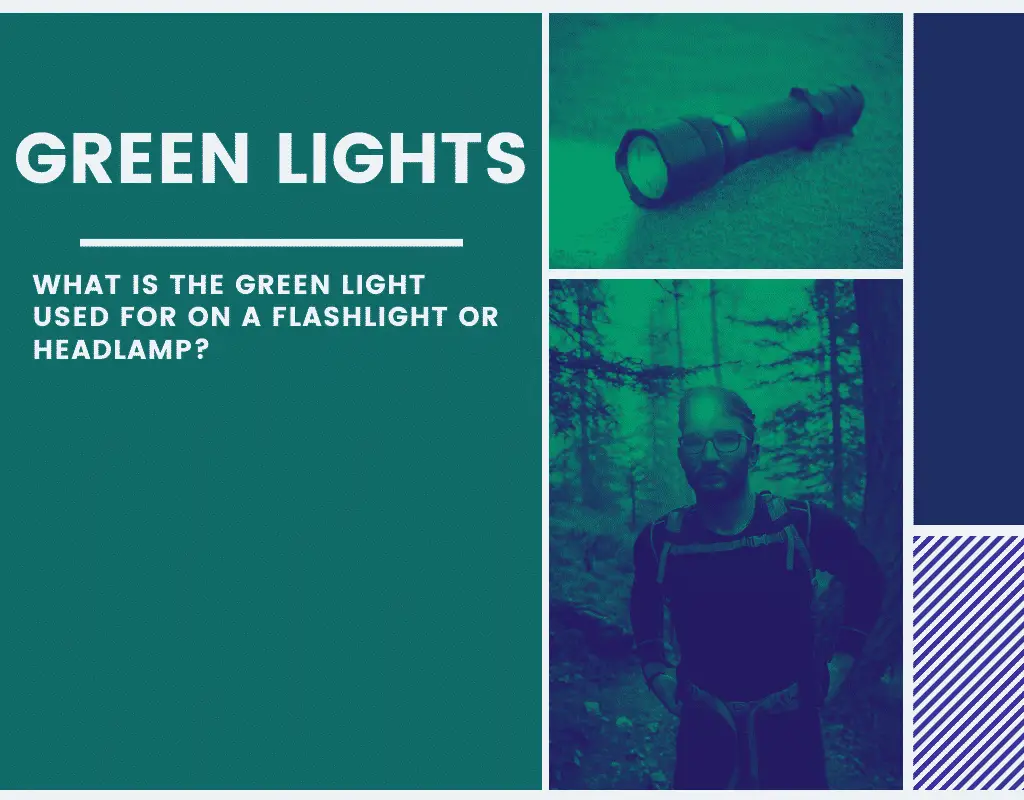After working my way through the settings on my new headlamp I stumbled across something I wasn’t expecting. It has the usual brightness settings, but I wasn’t expecting a green light mode instead of red. I’ve bought a lot of flashlights and headlamps over the years, but you rarely see a green light outside of military/hunting equipment. I really like using green lights so it was a pleasant surprise, but you’re probably wondering when you should use a green light?
What is the green light used for on flashlights and headlamps? Using a green light improves night vision by increasing the contrast and shortening the recovery time once you turn off the light. It plays a similar function to the red light setting, but the additional contrast allows you to see more detail so it’s easier to read small text in maps, compasses, and other instruments.
There is a tradeoff to using a green headlamp as opposed to red. Green lights help improve clarity/contrast, but red lights are better at preserving night vision. Your eyes will adjust faster than with a white light, but go with red if you don’t need to pick out finite details in the dark.
In the rest of this post I’ll talk about all of the benefits of using a green light, and go over a few scenarios where green lights make sense over other options. You can usually get buy with just red/white, but it’s always nice to use a flashlight or headlamp with a green light.
Table Of Contents
Why Do Headlamps and Flashlights Have A Green Light?
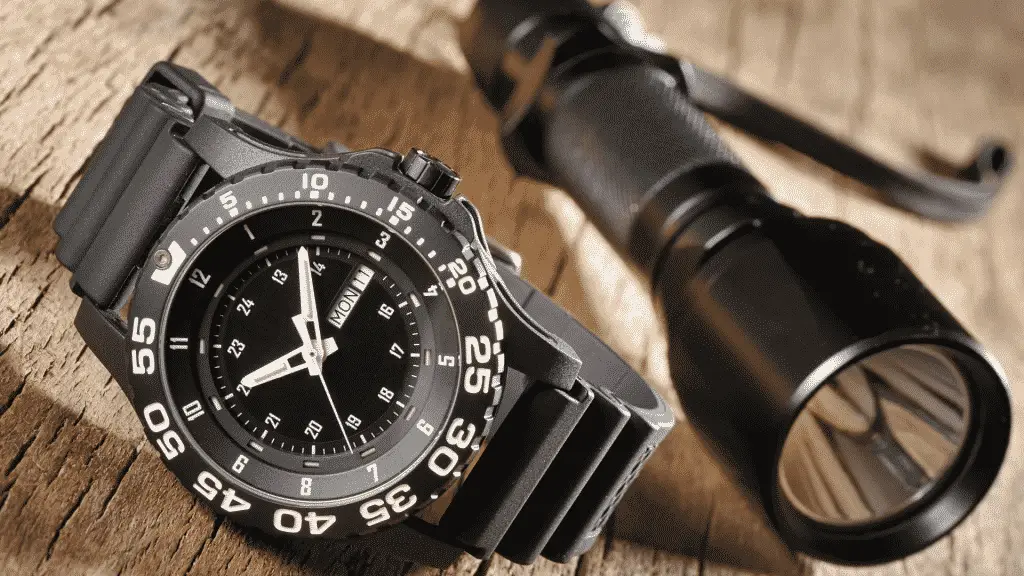
The vast majority of flashlights and headlamps have multiple white settings, sometimes have a red color option, but you rarely see a green light on high quality flashlights/headlamps (for general use). You usually only see a green light on hunting/military flashlights and cheap imported flashlights that are basically garbage.
I never realized that I’d need a green light until I had one. Using a green light allows you maintain your night vision in the dark while improving contrast and clarity. It helps your eyes focus and pick out detail, so you can read a map/compass, pick out small details, and see farther than with red/white lights.
You don’t have that harsh transition where your eyes have to adjust to a bright white light and you’ll maintain your night vision after shutting it off. Red lights are slightly better at maintaining night vision, but you won’t be able to see clearly up close and far away. It’s hard to explain, but there’s uneven clarity as you move from one edge of the red beam to the other.
I still prefer a white light when I’m hiking through the woods at night and red lights when I’m not worried about clarity moving around the tent without waking up my wife, but green lights are a great addition to your flashlight or headlamp.
I mentioned the only downside to using a green light (worse than red for preserving night vision), but lets go over all of the benefits. After that I’ll go over a few situations where it makes sense to use a green light (versus red) and give a few recommendations of my favorite headlamps and flashlights that have green lights.
Benefits Of Green Lights On Your Flashlight or Headlamp
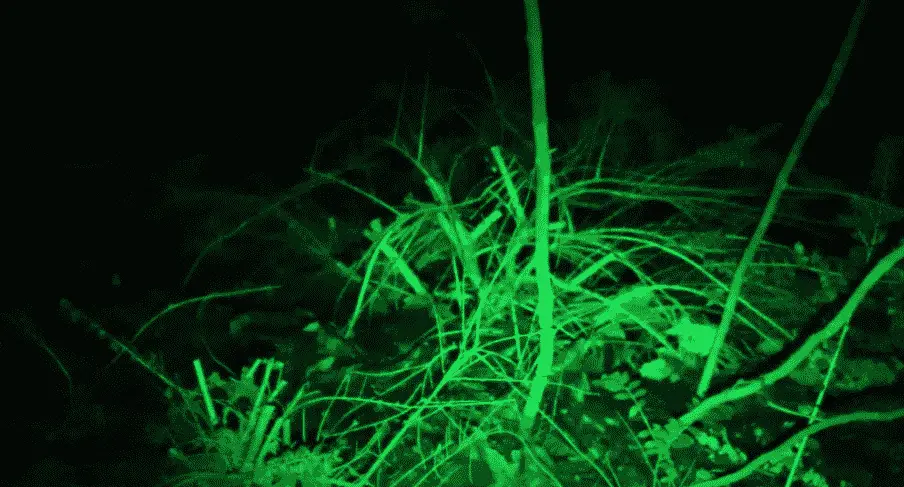
- Helps Preserve Night Vision: Having a white light shined in front of you is blinding at night. You immediately lose your night vision and it can take minutes for your eyes to adjust. Using green and red lights slows down the breakdown of the protein that your eyes use to absorb light so it helps preserve night vision over a longer time period.
- Sharp and Vivid Contrast: Green lights fall in the center of the visual color spectrum so it’s the easiest to see in the dark. You’ll have increased sharpness and contrast level of your surroundings. This improves close up vision (reading maps, compass, instruments, etc.), allows you to see farther, and pick out finite details in the dark. If you’re trying to track an animal or find something in the dark it’s better to use a green light.
- Provides Even Color Intensity: It’s hard to describe, but you’ll know what I’m talking about the next time you use a green light. Green lights provide even color intensity across the entire beam of light. There’s less of a fade away into darkness as you look out towards the edges of the beam. It goes from clean even green light to darkness.
- See Farther Away: The added contrast levels and better clarity allow you to pick out details at a distance and see farther away. You might be able to see farther and get a better field of view with white light, but it blurs the edges making it harder to spot objects at a distance.
- Green LED Bulbs Increase Battery Life: I have no idea why this is the case, but green bulbs use less electricity than other colors. A typical green LED light uses 30% less electricity than white lights and 10% less than red lights. So switching over to a green light will extend your battery life at a similar lumen level.
- Easier For Other Humans To See: This mostly applies to hunters and anybody that’s trying to signal for help, but humans are better at picking out green lights at night (than red). You don’t want to get shot by somebody that’s hunting at night. Technically it’s usually illegal to hunt game animals at night, but most states all you to hunt non-game animals like racoons, possums, coyotes, etc.
- Animals Have A Hard Time Seeing Green: The average human can see a broad spectrum of colors, but most animals have a hard time seeing greens and reds. I wouldn’t say that they’re colorblind, but they see most colors as a slightly color tinted gray. This allows hunters to use a light at night to find their gear and hunt, track, and spot wild game.
Here Are A Few Of My Favorite Green Lamp Headlamps and Flashlights
You will need to start off by deciding if you’d like to purchase a green light only or multicolored flashlight/headlamp. Green light only models are primarily used by hunters, and multicolored can be used for a wide variety of applications.
Multicolor Flashlights
- OLIGHT Freyr 1750 Lumens RGB Flashlight: Olight Freyr is a multicolor 1750 lumen RGB flashlight with a white, green, red, and blue lens. It has a 360 meter throw with the white light, which is much farther than most compact flashlights on the market. The colored LEDs have lower lumen ratings Green (60 lumens), Red (30 lumens), Blue (25 lumens) so they’ll go about 30 meters. So this is a great compact general use camping/hiking or everyday carry flashlight, but it won’t be great for hunting applications.
- Cyansky H5 Multi-Color Hunting Flashlight: This is a multicolor flashlight with a red, green, and white bulb. The green light is 300 lumens with a (313 meter throw), red light 100 lumens (180 meter throw), and white light is 1300 lumens (600 meter throw)
- Ledlenser P6R Core 4 Color Flashlight: Ledlenser’s P6R is a multicolor flashlight with 4 color options white, red, green and blue. It’s designed for general use instead of hunting so it has a lower 270 lumen ratings, but a much wider beam. So it won’t reach out as far (80-100 meters), but you’ll have more peripheral light closer to you.
Green Only Flashlights
- Acebeam E10 Green LED Flashlight: The Acebeam E10 flashlight uses rechargeable batteries and has a green light with multiple brightness settings. It has an ultranarrow optic with a ridiculously long maximum beam distance. It comes in 3 versions so make sure you choose the right one if you’re looking for a green hunting flashlight. The green version has 1050 lumens with a 675 meter throw. It’s a compact light cannon with one of the narrowest beams on the market (poor peripheral view).
- Weltool T10-HG Long Throw (Hunting Flashlight): This is a heavy duty green hunting flashlight since it only has a green light. It’s a super long throw green hunting flashlight with a 860 meter maximum range. You can actually see farther than most people can shoot which making it the perfect hunting flashlight for spotlighting animals out to 300-400 yards.
Multicolor Headlamps
There aren’t many quality RGB multicolor headlamps on the market. You only have a handful of options, but it’s easy to find a cheap headlamp with red, green, white, and blue lights.
- PETZL Tactikka RGB 250 Lumen Headlamp: Petzl Tactikka is a budget multicolor 250 lumen headlamp. That’s enough light for hiking/camping, but you’ll be limited for hunting. It’s great for close proximity lighting , but it has a limited 90 meter range.
- Black Diamond Storm 400 Headlamp: Black Diamond’s Storm 400 headlamp outperforms its price range. It’s a multicolored RGB headlamp with white, green, red, and blue color settings. It has a 100 meter beam distance with the white light, but you have a limited 20-30 meter range with the colors.
- Nitecore HC90 900 Lumen RGB Headlamp: This is one of the only long range multicolored headlamps that’s currently on the market. It has a 900 lumen rating and red, white, green, and blue color options. It has a high efficience long lasting battery with a wide 100° beam angle. That means you’ll have plenty of light in your peripheral, but it’s limited to 100-130 meters (still pretty far).
Is Red or Green Light Better For Night Vision?
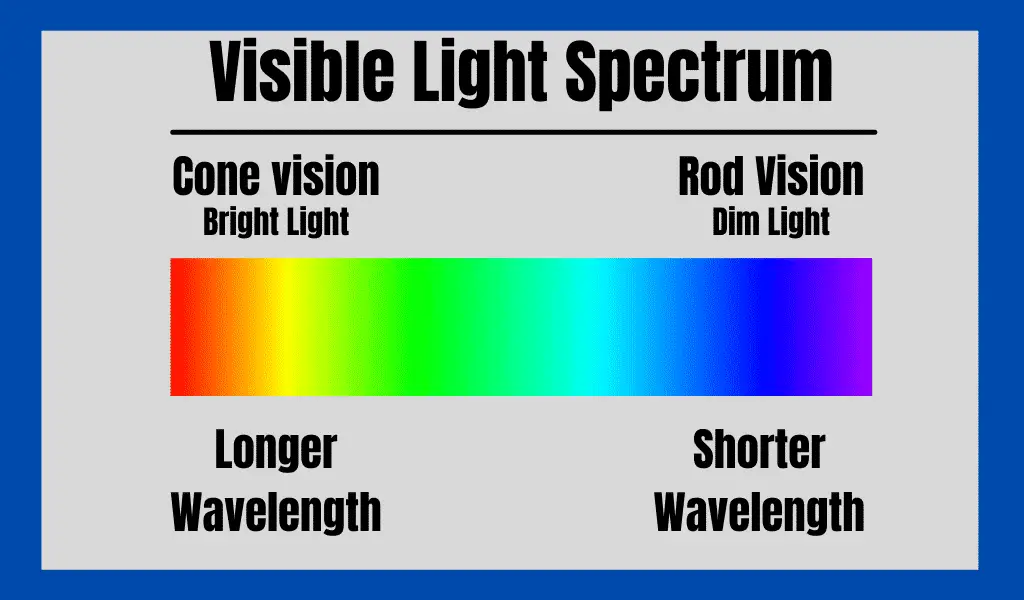
Choosing between green and red light settings will be a matter of personal opinion. Both options allow your eyes to adjust quickly in the dark, but they each have advantages and disadvantages. So when should I use a red or green light?
Red light is the winner if preserving night vision is your main objective, but it causes clarity and contrast issues. The part of your eyes that deal with night vision (the rods) are blind to red light so it’s only interpreted by the cones (bright lights and color).
So using a red light won’t have any affect on your night vision, but the cones have a hard time focusing in dim light. There won’t be enough light to properly function. This leads to clarity and contrast issues which affects closeup and far away vision. That’s where green lights start to shine!
Green lights fall in the center of the visible light spectrum. So it uses both the cones and rods to interpret the color/brightness making green the easiest color to see in the dark. This has a slight effect on night vision, but the added light increases contrast/focus.
Using a green light is preferred for tasks that require clarity. Trying to read instruments/maps, find a trail, track animals, and improves vision at a distance. That’s why the military uses green in their night vision goggles. It gives soldiers a better view of their surroundings while maintaining vision at night.
Green Lights Make Reading Maps, Compasses, and Other Gear Easier

I wouldn’t want to read an entire book with a green light, but the increased contrast/clarity will help you read for a few minutes without affecting your night vision. That’s great for when you need to look at a compass, read a map, or adjust a piece of your gear in the middle of the night.
You can get a similar effect with a low lumen “Midnight Mode” 2-3 lumen white light, but once you go above that it will affect your night vision. Red lights make it hard to focus on the page and blue lights provide too much detail and alert animals in your surroundings.
Green Lights Make It Easier To See Objects At A Distance
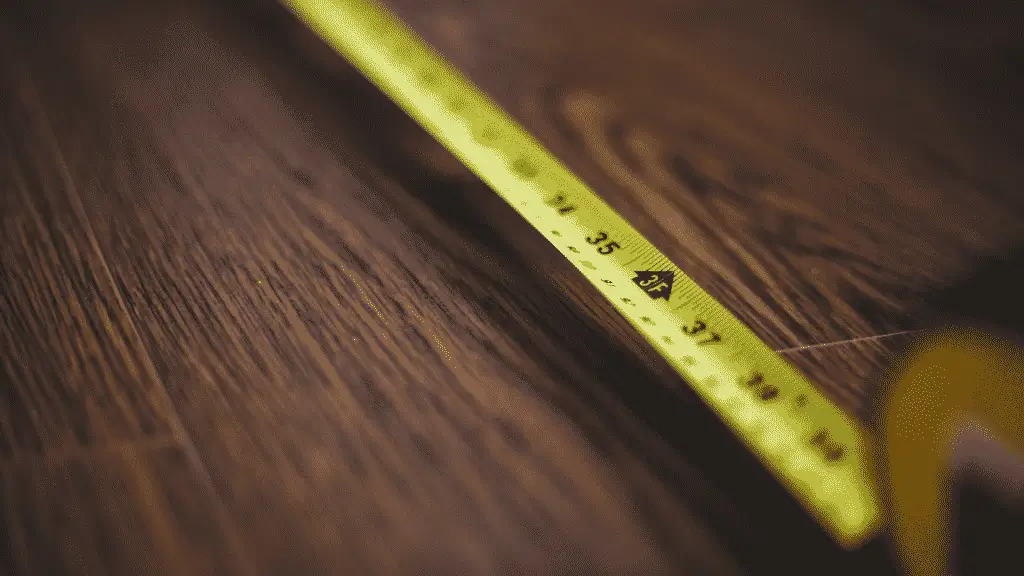
There’s a reason why most military night vision goggles and long throw hunting flashlights use green lights. It improves the contrast and clarity of objects at a distance. So you’ll be able to spotlight animals from 300+ meters away using a green light with a long beam distance.
It doesn’t matter what color the object is! Green lights will break up the outline providing a clear view regardless of the distance. If your max beam distance can reach the animal/object, you should be able to see it.
Green Lights Help Hunters Track and Kill Wild Game
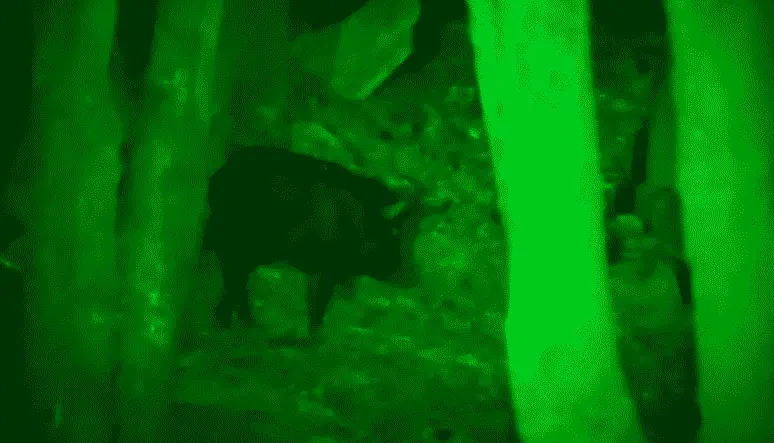
White lights are great for illuminating the surroundings, but they’ll scare off animals in an instant. That’s where colored lenses come in. Red and green colored lights aren’t as harsh as white lights so they’re less likely to scare away animals.
Red lights are the go to option for most seasoned hunters, but green lights have been increasing in popularity over the years. It’s mostly caused by the increased popularity of feral hog hunting. The added contrast of green lights help hunters pick out the outline of dark haired hogs in the dark and they have a harder time seeing green than red.
It’s better to use a red light with most other animals, but some predator hunters prefer green lights as well. Most predators can pick out green easier than red, but it’s much safer to hunt large predators at a distance so the added clarity of green lights helps them see farther away. The only time it’s always better to use green lights on predators is when hunting coyotes, racoons, fox, bobcats, and smaller animals.
Green lights will also help you climb in and out of your treestand in the dark. You don’t have to worry about scaring animals away with the light and it’s easier to see where you’re stepping.
